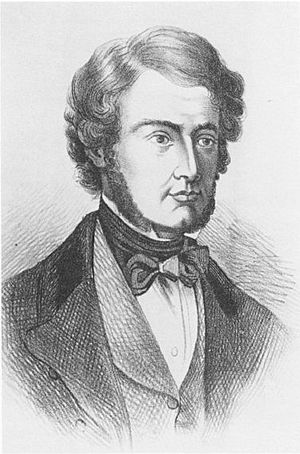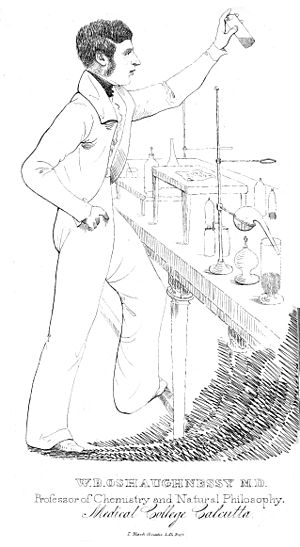William Brooke O'Shaughnessy facts for kids
Quick facts for kids
William Brooke O'Shaughnessy
|
|
|---|---|
 |
|
| Born | October 1809 |
| Died | January 1889 (aged 79) |
| Education | University of Edinburgh |
| Known for | Intravenous therapy Telegraphy Forensic chemistry |
| Medical career | |
| Profession | Doctor, physician, inventor |
| Institutions | Medical College and Hospital, Kolkata |
| Awards | Fellow of the Royal Society |
Sir William Brooke O'Shaughnessy (born October 1809 in Limerick, Ireland – died January 8, 1889, in Southsea, England) was an amazing Irish doctor and inventor. He was known for his work in medicine, chemistry, and for creating the telegraph system in India. His medical research helped develop intravenous therapy, which is a way to give fluids directly into a patient's veins.
Contents
Early Life and Discoveries
William O'Shaughnessy was born in Limerick in 1809. He studied at Trinity College, Dublin, and then moved to Scotland. In 1829, he earned his medical degree from the University of Edinburgh Medical School.
When he was only 22, William made a very important discovery. He studied the blood of people suffering from cholera, a serious disease. He found that their blood was low in water, salt, and other important substances. He believed that putting salts back into the body could help. This idea, along with the work of Thomas Aitchison Latta, led to the development of intravenous therapy. This is a method where doctors put fluids and medicine directly into a patient's veins.
After his studies, O'Shaughnessy joined the British East India Company in 1833. He moved to Calcutta, India, where he worked as a doctor and a professor at the Medical College and Hospital, Kolkata. He also became a chemical examiner for the government. In this role, he developed ways to detect poisons like arsenic in forensic studies.
Amazing Work in India
During his time in India, William O'Shaughnessy worked on many different scientific projects. He studied plants for medicine, chemistry, and how electricity could be used underwater. He even figured out that zinc could stop iron from rusting, which was before the process called galvanizing became common.
He also worked on improving education in India. He believed that medical education should be available in local languages. He also wanted doctors to use local plants for medicine, as they were cheaper and easier to find. He wrote a Manual of Chemistry and a book called Bengal Dispensatory and Pharmacopeia. This book described many local plants and their uses in medicine.
In 1843, he was chosen to be a Fellow of the Royal Society. This is a very high honor for scientists. The Royal Society recognized him for his knowledge in medicine and chemistry, and for helping to improve education in India.
Building the Telegraph Network
In 1844, O'Shaughnessy returned to India. He started working on a huge project: building a telegraph network across the country. A telegraph uses electrical signals to send messages over long distances.
He was appointed Superintendent of Telegraphs in 1852. Between 1853 and 1855, an amazing 3,500 miles of telegraph lines were installed across India! He wrote many guides and reports about his telegraph inventions. His work helped India get messages quickly, which was very important for communication and even for moving troops during difficult times. For example, in 1857, a message sent by telegraph from Delhi to Punjab helped move soldiers in time. In 1858, a telegraph cable was even laid under the sea between India and Ceylon (now Sri Lanka).
Knighthood and Later Life
In 1856, Queen Victoria made him a knight for his incredible work on the telegraph in India. He was then named the Director-General of Telegraphs.
After this, O'Shaughnessy continued to write about telegraphy, even creating a book of secret codes for sending encrypted messages. In 1860, he returned to Europe due to illness. He passed away in Southsea, England, on January 8, 1889.
He changed his last name to Brooke in 1861 after a relative passed away.


